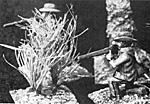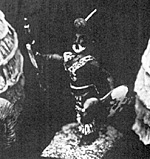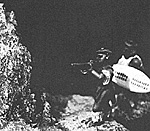 Wargaming literature abounds with information and advice on how to make the terrain on your table-top look as realistic as possible. It is not the purpose of this short article to tell you how to make hills or rivers; there are plenty of available sources for that. Most of them, however, describe terrain applicable primarily to Western hemisphere countries - America and Europe. The wargamer turning to the Colonial period may find himself wondering just what the country-side in which he is fighting looked like, and just how to represent it on the table.
Wargaming literature abounds with information and advice on how to make the terrain on your table-top look as realistic as possible. It is not the purpose of this short article to tell you how to make hills or rivers; there are plenty of available sources for that. Most of them, however, describe terrain applicable primarily to Western hemisphere countries - America and Europe. The wargamer turning to the Colonial period may find himself wondering just what the country-side in which he is fighting looked like, and just how to represent it on the table.
What follows is not an exhaustive description of every theatre of war fought in by the European (primarily British) Empires during the nineteenth century, but rather a few hints which I have found useful in the past. Some will be applicable to both 15mm and 25mm scales, some just to the latter, and some may only be practical in skirmish games. Tufts of grass, for exainple, may play a significant part in a skirmish involving only a handful of figures on a small table, but only the most dedicated of players would spend the time necessary to cover half of a full-sized board in a reconstruction of lsandhlwana!
The first tip is to consult as many pictorial sources as possible. Contemporary newspapers covering British campaigns were usually profusely illustrated with drawings executed 'on the spot' and are therefore invaluable references for seeing exactly what the terrain was like. Consult modern travel books, too, and even travel brochures produced by holiday companies. These often have lots of glossy colour photos which all but help to build up a picture of what you are trying to represent.
 In some theatres, very little scenery will be needed. It would be quite acceptable to fight battles set in the Sudan campaigns on a board completely devoid of scenery, except perhaps for the odd palm-tree or hill. On the North-West Frontier of India, rugged mountains were the order of the day, so use as many hills as you have, augmented by suitable stones - masquerading as boulders in scale - from the garden.
In some theatres, very little scenery will be needed. It would be quite acceptable to fight battles set in the Sudan campaigns on a board completely devoid of scenery, except perhaps for the odd palm-tree or hill. On the North-West Frontier of India, rugged mountains were the order of the day, so use as many hills as you have, augmented by suitable stones - masquerading as boulders in scale - from the garden.
For jungle areas, such as Ashanti in West Afica, the best bet is to use as much modeller's lichen as you can muster, interspersed with a few spreading trees. This will give the impression of dense undergrowth, but cut down the problems of moving figures about under too many trees; you know no matter how careful you are, there is always one tree which falls over every time you move a figure within six inches of it!
On the subject of trees, a little thought can produce effective results. Commercially produced tree models often look out of place in an African or Indian setting, although pines are perfectly acceptable in India's hill country, and spreading trees can be employed in jungle settings. In many dry, hot areas, low flat trees, such as mimosas, are the most common. To represent this, try using commercially available trees partially assembled leave the top sections off, and they look decidedly African!
Buildings, too, can help to create the right atmosphere of period and place. In India and the Sudan, they were mostly square, made of mud-brick and with flat roofs. This type of building, rather like the Mexican adobe huts we've all seen in countless Westerns, can be simply made out of cardboard or balsa. If you are feeling adventurous, try giving the outside a coat of plaster, which will make it look much more like the real thing.
Some unusual buildings may require special attention, Zulu huts, for example, with their distinctive beehive appearance. Try cutting a ping-pong ball in half along the seam; this will give you two domes. Use card, rolled into a short tube, to form the walls so that the dome is the roof. Cover the whole thing with a filler paste, and when this in nearly dry, scratch on a thatch marking. The result is very realistic. The dome, incidentally, can also be used to form the tops of mosques in Frontier or Sudan games! Keep an eye open, and you will soon see similar domes, smaller or larger, which can be used when a different scale, or simply a bigger or smaller hut is required.
In the Sudan, European dwellings were usually grander versions of native buildings and can be tackled in the same way. In India, they were usually long and low the bungalow originated in India - and some commercially produced models can be adapted quite easily. In South Africa, farmhouses (Rorke's Drift, anyone?) were usually one story, made of brick or stone, with a thatched or corrugated iron roof and a veranda. Make the walls out of balsa or card, iron roofs from corrugated card, and represent thatch by scratching into wet filler paste or by using the strands from garden string.
Dried up rivers or water-courses are very much a feature of Colonial terrain, in everything from the charge of the 21st Lancers at Omdurman to the death of the Prince Imperial in Zululand. They can be tricky to represent on the table-top. For the wide gullies of the Sudan, use polystyrene tiles, the sort used for home decoration, painted sand-color with water paints, or bark tiles. Layer these so that the approach to the gully is stepped in shallow contours; then leave as deep a gap as possible between tiles for the gully itself.
 The smaller 'dongas' of South Africa can be more of a problem, since they gouge the top-soil in convoluted 'crow's-foot' flow patterns and vary in size from a foot across and six
inches deep to a hundred yards across and twenty feet deep. The simplest method of representing them is to lay out a trail of stones to mark either bank; if you want to be more adventurous, experiment by dripping polystyrene glue onto polystyrene tiles. Whilst wet, the glue will eat into the tile in much the same way that the rain washes out the soil on the real thing, and a quite realistic result can be achieved.
The smaller 'dongas' of South Africa can be more of a problem, since they gouge the top-soil in convoluted 'crow's-foot' flow patterns and vary in size from a foot across and six
inches deep to a hundred yards across and twenty feet deep. The simplest method of representing them is to lay out a trail of stones to mark either bank; if you want to be more adventurous, experiment by dripping polystyrene glue onto polystyrene tiles. Whilst wet, the glue will eat into the tile in much the same way that the rain washes out the soil on the real thing, and a quite realistic result can be achieved.
For skirmish games, clumps of long grass and other cover such as ant-hills can prove interesting obstacles. Use the splayed out ends of garden string to represent grass; use a piece of wire to tie-off the bottom end of a suitable clump, and sink it into wet filler on a small card base. The grass can either be left string-brown, or painted green. Anthills grow to enormous heights in parts of South Aftica, and were frequently used for cover during the Boer and Zulu Wars. Almost anything can be used as the basis of an anthill; small stones, left-over pieces of cork, rolled up silver paper. Stick them to a card base, and when dry cover them in a mix of water-solvent glue and builder's sand. The effect is highly realistic.
The key to making attractive terrain for colonial games is much the same as for European or American ones; find out the effect you want, and keep your eyes open. With a bit of imagination, a surprising amount of items can be employed to achieve some very attractive results!
Back to Table of Contents -- Courier Vol. III #3
To Courier List of Issues
To MagWeb Master Magazine List
© Copyright 1981 by The Courier Publishing Company.
This article appears in MagWeb (Magazine Web) on the Internet World Wide Web.
Other military history articles and gaming articles are available at http://www.magweb.com